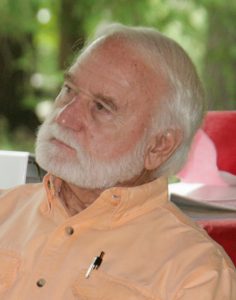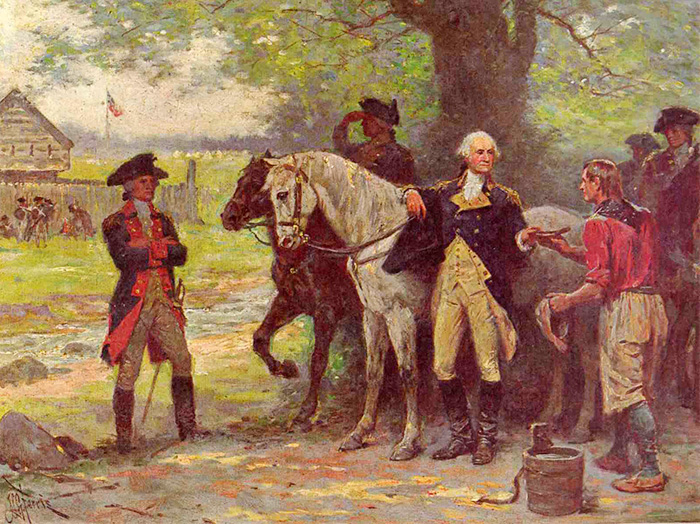Editor’s note: This story is excerpted with permission from the Summer 2023 edition of the Fort George Post, The Newsletter of the © Lake George Battlefield Park (Fort George) Alliance.
By Dr. Russell P. Bellico

In the spring of 1782 George Washington established his headquarters in Newburgh at the Hasbrouck House, overlooking the Hudson River.
In July 1783 Washington decided to make an inspection tour of the “Northern and Western Posts” in New York, where “important Military” events had occurred during the war.
On July 15, Washington wrote to Philip Schuyler that he had sent Lieutenant Henry Dimler, the assistant quarter master general, to make arrangements for “some light Boats [bateaux]…[to be] transported to Lake George.”
Washington departed from Newburgh on July 18 for his trip to the sites on the northern frontier. In addition to a complement of troops, the entourage included Governor George Clinton, two field officers, and an Italian nobleman.

On a tour of America, Count Francesco dal Verme had a number of letters of introduction, including ones from Benjamin Franklin and John Adams.
Washington did not write much about the excursion except for his list of expenses, but fortunately Count dal Verme would write an interesting account of the journey.
On July 19 Washington’s party lodged at Philip Schuyler’s “magnificent” home in Albany, offering a “panoramic view” of the river valley.
In addition to a fine dinner, Schuyler provided three-and-a-half gallons of liquor to his guests, purchased from James Caldwell, an Albany merchant and future settler of Caldwell (Lake George Village).
Among the guests were two of Schuyler’s daughters — one, Elizabeth, was the wife of Alexander Hamilton, then serving in the Continental Congress.
Traveling by horseback, the next day the party observed “the place where General [John] Burgoyne first engaged the American forces” and spent the night at Schuyler’s home in present-day Schuylerville.
On July 21 the group met “more than two hundred” repatriated prisoners, returning from captivity in Canada, as they made their way through Saratoga.
Traveling by horseback, the next day the party observed “the place where General [John] Burgoyne first engaged the American forces” and spent the night at Schuyler’s home in present-day Schuylerville.
On July 21 the group met “more than two hundred” repatriated prisoners, returning from captivity in Canada, as they made their way through Saratoga. Later that day Washington’s party “arrived in the evening at Fort George, now dismantled,” where “fishing provided our supper, and we extended our mattresses in a house of only one room.”
The accompanying soldiers, mainly from a Rhode Island battalion stationed at Saratoga, erected their tents in today’s Lake George Battlefield Park.
The following day (July 22) dal Verme recorded that the horses were left with 30 soldiers at Fort George. Washington and his party viewed Fort George and the remnants of Fort William Henry, but dal Verme didn’t offer any details — whether this occurred before departing for Ticonderoga or on the return leg.
Washington’s entourage departed northward for Ticonderoga aboard three bateaux that had been transported overland from Fort Edward:
“We, thirty-nine persons in all, got into three boats, each of which carried six armed soldiers who did the rowing.”
They had brought provisions of biscuit, beverages, and one live sheep. However, their main staple — fish — was caught while underway for their dinner that day.
Washington and his detachment reached the northern end of the lake at eight in the evening and slept in tents for the night, eating fish once again for breakfast.
During the day of July 23, while two bateaux were being carried to Lake Champlain, the party visited the “remains” of Fort Ticonderoga, then traveled north by boat to Crown Point “where some fortifications are still standing,” eating lunch in a “hut.”
After lunch the detachment embarked southward, “pitch[ing] our tents by the lakeside, but the mosquitoes would not let us sleep.”
On the 24th they arrived back at the Lake George portage and pitched their tents again, having both a breakfast and dinner of fish, while waiting for the boats to be transferred back to Lake George.
In his journal of the trek, dal Verme commented more about the wildlife that he observed than the forts, describing a nine-foot-long rattlesnake killed at Fort Ticonderoga, a large black bear at Crown Point, another bear and her two cubs that snatched their live sheep at the northern Lake George portage, and the “incessant screaming of panthers” during the last night at the portage.
Washington’s party departed from the portage at three in the morning of July 25, landing at one o’clock in the afternoon on an island, 18 miles from their embarkation. Their steady diet of fish continued on the island. “Our catch of fish,” according to dal Verme, “was so plentiful that we kept only the best,” including perch, pike, and red trout.
The group arrived at Fort George after dark to find “bowers [rustic temporary shelters] lighted by torches of dry wood”; the structures had been constructed by the soldiers who had remained at the site of Fort George.
On the fort grounds, Washington met with Major General Baron Friedrich Wilhelm von Steuben, who was being dispatched by Washington, in accordance with Article VII of the provisional peace treaty, to meet with Governor Haldimand in order to facilitate the surrender of the British-held frontier posts.
However, when Steuben arrived in Canada, Haldimand maintained that he did not have the authority to relinquish the posts until receiving further instructions from home.
On July 26 Washington and his entourage left for Fort Edward and then for Schuyler’s home in Schuylerville, observing sites of destruction from the 1777 battle.
The next day, after visiting the nearby mineral springs, Washington met with ambassadors from the Oneida and Tuscarora Nations (most of whose warriors had supported the Americans during the war), approving their request for powder, ammunition, and rum.
Thereafter, the party visited Old Fort Johnson, Fort Rensselaer, Fort Herkimer, Fort Dayton, Fort Schuyler (Fort Stanwix), and Otsego Lake.
On August 3 Washington returned to Schenectady, where he was “honored here by many Indians, around two hundred in all from the two nations allied with the Americans.”
The next day he set off by boat for his headquarters in Newburgh.
The tour by Washington was not in reality a matter of leisure — it was an evaluation of the feasibility of strengthening military posts, especially on the western frontier.
From his headquarters in Newburgh on August 6, Washington wrote to the president of Congress that his tour was “to facilitate…the operations which will be necessary for occupying the Posts which are ceded by the Treaty of Peace,” and therefore he began preparations “for supplying all the Garrisons on the Western Waters.”
Washington also ordered Colonel Marinus Willett “to repair the Roads, remove the obstructions in the [Mohawk] River,” and construct buildings for “Ordnance and Stores.”
In addition, Washington informed the superintendent of finance that as a result of his “Tour to the Northward,” the quartermaster general would be receiving orders “to prepare Batteaux and other means of Transportation to the Upper Posts, of the Cannon, Stores and Provisions” needed in “Maintaining them.”
With the end of the war, the plan of maintaining fortifications on the northern frontier ended.
Settlements expanded in the Champlain Valley and the forts became convenient sources of building materials.
However, four settlers, who received a one-year lease for the land at Fort George in 1783, had to agree to a stipulation that no “Bricks, Timber or Stones… be removed” or fortifications “taken down.”
A new era of peace at Lake George had begun. Fort George, as well as the other forts in the region, served as the first line of defense on the frontier against the British.
Many Americans made the ultimate sacrifice of their lives at these outposts.
In his circular letter of June 18, 1783, written at his Newburgh headquarters, George Washington admonished his fellow countrymen to recognize the “meritorious class of veterans” of the war “who have shed their blood, or lost their limbs, in the service of their country.”
Those sacrifices resulted in the independence of the American colonies, becoming the first modern democracy in the world.
Dr. Russell P. Bellico, a Lake George Battlefield Alliance trustee, is the author of Empires in the Mountains: French and Indian War Campaigns and Forts in the Lake Champlain, Lake George, and Hudson River Corridor (2010), and other works on North American military and maritime history.
Copyright © 2023 Lone Oak Publishing Co., Inc. All Rights Reserved
 Glens Falls Chronicle Serving the Glens Falls/Lake George region; Warren, Washington and northern Saratoga counties since 1980
Glens Falls Chronicle Serving the Glens Falls/Lake George region; Warren, Washington and northern Saratoga counties since 1980


